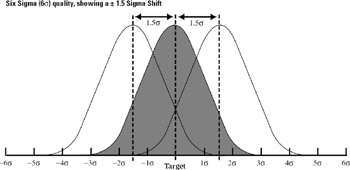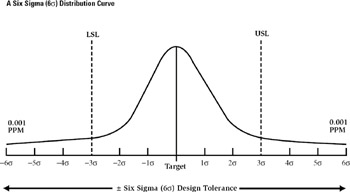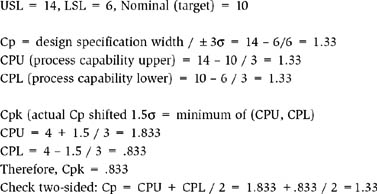Basic Six Sigma Metrics and Other Considerations
This section discusses some very important concepts, illustrates the power of these tools in the decision making process, and explains some basic calculations relevant to Six Sigma design (DFSS) or process work (PFSS).
1. Change management
Frequently, executive management will only "react" when the dissatisfaction (customer complaints, amount of rework, increased costs, etc.) exceeds the costs (funding, resources) to fix the problem. This can be expressed as follows:
![]()
Where:
-
C = Change — could be DFSS or PFSS
-
f = a function of
-
D = Dissatisfaction — with the present state (problem)
-
P = Process — that may be DMADV or DMAIC
-
E = Expertise — trained Green Belts/Black Belts working with Six Sigma teams
-
> = greater than
-
$ = Bottom-line costs to eliminate or reduce the problematic condition
2. A change in factorial experiments
The DFSS process includes many diverse tools, among them the Design of Experiments (DOE) that attempts to identify, by checking the main effects and interactions, the optimum combination of factors (x) to meet a product design requirement (Y). D.H. Stamatis (2002) provides some advice:
The DMAIC model focuses on fixing problems, whereas DFSS [DMADV] focuses on prevention and robustness. Robustness is indeed the design's focal point if we are serious about improvement. The traditional model of Y = f(x) is no longer appropriate, We must focus on the Y = f(x, n). Therefore, the requirements at this stage are to optimize product and manufacturing/assembly process functions by testing in the presence of anticipated sources of variation [i.e. noise (n)] (p.48).
3. Defects/rework determine first-pass yield
The diagram below illustrates how defects during assembly can affect the total output or yield.
| INPUT | STAGE 1 | STAGE 2 | STAGE 3 | OUTPUT | ||||
| Sub-assemblies | – – – – | – – – – | – – – – | Result: 903 fully | ||||
| and parts for | → | 95% | → | 96% | → | 99% | → | assembled units |
| 1000 units | – – – – | – – – – | – – – – | to the customer | ||||
| 50 defects | 38 defects | 9 defects | ||||||
| 950 units | 912 units | 903 units |
![]()
4. SIPOC, a widely used tool in Six Sigma work
SIPOC is an acronym for Supplier-Input-Process-Output-Customer. It illustrates the process flow from supplier to customer. For a more detailed description, please refer to tool # 195, "Systems Analysis Diagram" in this book. Another SIPOC application example is shown below of an organization that is striving for Six Sigma quality. It assumes 1000 Video Cassette Recorders in production.
| SUPPLIER | INPUT | PROCESS | OUTPUT | CUSTOMER | ||||
| – – – – – | – – – | – – – – | – – – – | – – – – – | ||||
| .985 | → | .997 | → | .994 | → | .995 | → | .998 |
| – – – – – | – – – | – – – – | – – – – | – – – – – | ||||
| Defective parts received | Kitting, document errors | Assembly defects (rework) | Tested out defects (QC) | Escaped defects (returns) | ||||
| (15) | (3) | (6) | (5) | (2) |
Therefore, product/process quality = (.985 x .997 x .994 x 995 x .998) x 100 = 96.9%
Also, Cost of Poor Quality = Defects per unit (DPU) x Volume x Mean Cost/Defect
Given that most organizations still work and produce at the 3-4 Sigma level of quality, this example does show that even small improvements at every stage will give a significant payback in total quality!
5. The concept of "Defect Budgeting"
This process is an objective approach to assign defect or error elimination activities to the organizational department identified as the source of the defects. For example, a Pareto Chart (refer to tool# 130 in this book) indicates:
-
65% of the defects caused during assembly
-
15% of defects due to faulty material from the supplier
-
12% of defects caused during painting
-
8% of defects traced to packaging and shipping
These results give first priority to Assembly, and their given objective would point to a requirement of 65% reduction in defects in the overall assembly process. Next, the supplier would receive a reduction of faulty materials notice in order to close a 15% quality gap and so on, right across to all departments that have been identified as defects contributors.
6. A brainstorming tool that truly returns breakthrough ideas!
Many times teams are disappointed with their own brainstorming results. They just do not come up with any fresh ideas that could make the difference! This book contains what this writer considers to be, the best brainstorming tool — tool # 70, "Double Reversal." This tool not only asks for the normal brainstorming input of ideas, it also asks the team for a second round of ideas to make this problem worse, as people always seem to be better at thinking of ways to destroy or make things worse. These ideas, once listed, are then negated and added to the original list of brainstormed ideas. It is truly amazing what ideas are produced, ideas that rarely would have been mentioned during the normal, straightforward way of brainstorming.
7. Pugh-type decision making methodology tools
Six Sigma books and articles frequently describe a scoring matrix called a Pugh Matrix used for comparing alternatives. It is popular because it is easy and fast construct and allows many variations for scoring. The basic Pugh Matrix requires six basic steps, completed on a flipchart:
-
Step 1: Team brainstorms the criteria to be used for comparison
-
Step 2: Team facilitator determines scoring — this could be a simple three level Scores of +, 0, −, or five levels of scores of + 2, + 1, 0, −1, −2, or even finer
-
Step 3: Team facilitator lists the alternatives to be compared
-
Step 4: Team compares and assigns scores of +, 0, or — to alternatives
-
Step 5: Team facilitator totals scores
-
Step 6: Facilitator then ranks the top three choices (alternatives)
For a variation of this method, refer to tool #144, "Problem Selection Matrix" in this book.
Other matrix decision-making tools in this book are:
-
Comparison Matrix, tool # 36
-
Paired Comparison, tool # 128
-
Selection Matrix, tool # 177
-
Solution Matrix, tool # 183
8. Calculate and validate team results of quantitative and qualitative improvements
in team-based organizations, questions always come up regarding how one reports (converts) qualitative improvements into a $ figure. Another concern is present whenever two or more teams are working in the same process area and report their results independently and at different times; how is the overall effect measured? It could indeed become very difficult to assess the overall improvement cost savings. For example, suppose there are two teams working to reduce process cycle time, materials cost, or defects, and they have achieved the following improvements:
Presently, a work cell assembles 10 switches for $1000 — this is the baseline measurement. $100 per switch before changes
| Team A has found a way to | 10 switches for $900 | — a quantitative result |
| reduce material costs by 10% | ||
| Team B has conducted | 12 switches for $1000 | — a qualitative result |
| retraining and was able to reduce rework by 20% | ||
Both teams report their success to the department manager. Team A reports a 10% cost savings, and Team B reports, two weeks later, a 20% cost savings. Is the manager correct in reporting an overall 30% reduction in costs? No! The bottom-line will only show an overall 25% saved, since $900 divided by 12 Units equals $75 per switch instead of the $100 before changes.
| The work cell now assembles | 12 switches for $900 — Teams A and B |
The point is that whenever many teams work on several processes or known problem areas, careful accounting practices need to be in place to measure, with validity, a team's performance.
9. A powerful tool to measure progress of all Six Sigma implementation activities!
Six Sigma Champions with overall reporting responsibility could use tool # 121 in this book, "Objectives Matrix" (OMAX), to verify the status of all Six Sigma implementation activities, or they could use it as an ongoing, monthly Six Sigma project progress reporting tool. This tool tracks work by percent completed on all stated objectives, shows what activities may fall behind schedule, and provides a composite index value that represents the combined progress of all activities.
10. Six Sigma (6$$) and the Shifted Probability Curve
The difference in quality levels can be explained by examining the figures below. With a non-shifted curve, only 2 defects per billion parts or opportunities would be expected. With a curve shifted 1.5 σ from the center or the process nominal (can be controlled within the target area 1.5 σ), only 3.4 defects per million parts or opportunities would be expected. The table below can represent this relationship:
| Shift | 3σ | 3.5σ | 4σ | 4.5σ | 5σ | 5.5σ | 6σ |
| 0 | 2700 | 465 | 63 | 6.8 | 0.57 | 0.034 | 0.002 |
| 1.5σ | 66,803 | 22,800 | 6,200 | 1,350 | 233 | 32 | 3.4 |
Defects per Million Opportunities (DPMO) can be calculated as follows:


Why the 1.5 Sigma shift? Mikel Harry, a recognized Six Sigma guru, has often claimed in his writings that there is a 1.5σ shift in long-term, highly consistent processes. Sammy Shina (2002) explains this 1.5σ shift, which has been widely adopted as a standard, as follows:
The Six Sigma concept, as described by most companies, assumes that the average quality characteristic of parts being produced can vary as much as 1.5σ Sigma from the specification nominal … This 1.5 Sigma shift of the average was developed from history of process shifts from Motorola's own supply chain. This makes Six Sigma defect calculations inclusive of normal changes in the manufacturing process (p.41).
11. Understanding Process Capability
First, to aid in the understanding of some simple calculations, the reader should review some background information provided by tool # 119, "Normal Probability Distribution", and tool # 184, "Standard Deviation."
Sigma is a measure of variability. The smaller the computed value of Sigma (or Standard Deviation), the tighter the normal curve and, therefore, the more products or processes will appear near the nominal or target value.
Cp: Process capability is often defined as the range of natural process variation. It reflects the best ability to process or perform within established lower and upper specification limits (LSL — USQ and as measured to (3( under the curve.
Cpk: Actual or located process capability is the measure of performance relative to the design target value under the curve.
At this point, the reader is asked to refer to tool # 147, "Process Capability Ratios," for a detailed description and calculations of Cp and Cpk.

Example of design tolerance at 4σ

Check: Cpk = Cp (1−k), k = Target − Actual /1/2 (USL-LSL) = 10 - 14/ (14−6) = 1
Cpk = 1.33 (1) = 1.33
Example of design tolerance at 6σ

We can now construct a table of Process Capability (Cp):
| 6 Sigma | 4.5 Sigma (1.5σ shifted) | Cpk |
| 6 | 4.5 | 2.00 |
| 5 | 3.5 | 1.67 |
| 4 | 2.5 | 1.33 |
| 3 | 1.5 | 1.00 |
EAN: 2147483647
Pages: 326